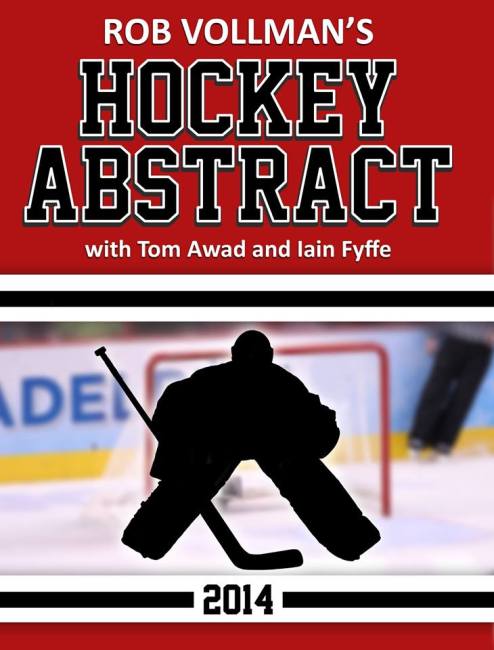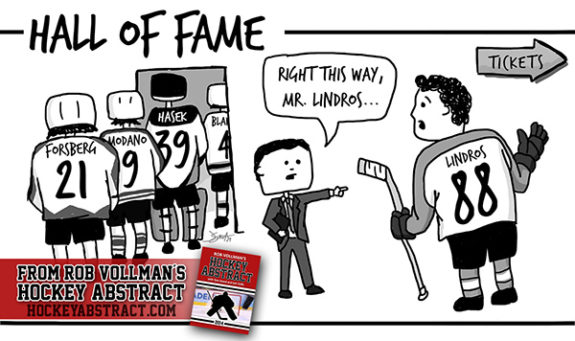In a day and age where many hockey fans are starting to try to understand the complex worlds of Corsi, Fenwick, and advanced statistics in general, it’s nice to know that there are authors out there that will dedicate themselves to breaking down statistical analysis to the most fundamental levels.
In his book, Rob Vollman – along with Tom Awad and Iain Fyffe – collectively break down the reasons why certain hockey plays happen, how specific players can be more apt at making such plays happen, and why these players can bring about such situations. More importantly, Vollman, Awad, and Fyffe raise a number of interesting questions throughout the text – questions regarding the Hall of Fame, shot quality, penalties, power-plays, and a slew of other hot topics that any statistically-oriented individual has probably wondered for some time.
Utilizing a very engaging and thorough narrative, Vollman, Awad, and Fyffe successfully guide the reader through a series of sections that cover almost every aspect of hockey statistics for forwards, defensemen, and goaltenders. So, if you’ve ever wondered about the world of advanced statistics or have wanted to understand the math and science behind certain hockey players and the plays that they make, then Hockey Abstract would definitely be the book for you.
The Player’s Side

Throughout Vollman’s book, one can get a glimpse into the world of a skater or a goalie, but not in the conventional way that one would think. Of course, Hockey Abstract contains sections such as a “Goaltending Q & A,” but Vollman, Awad, and Fyffe bring the reader into a players’ world by by exploring the composition of a given player.
Surely, every hockey fan has wondered what makes a specific skater or goalie good or bad or who the best goal scorer, penalty killer, or power-play specialist in the NHL might be. While Hockey Abstract certainly does employ a great amount of statistical analysis in order to back up the claims that their respective authors make, it is done in a way that could make such analysis comprehensible to individuals that might not be as polished as others as to the statistical analysis side of hockey.
In particular, the way that Tom Awad analyzes what makes forwards, defensemen, and goalies good is what makes this book so successful. One can tell the meticulous lengths that Vollman, Awad, and Fyffe went to in order to propose and defend the stances that they take in their book.
Analyzing why certain forwards get more ice-time than others during even-strength and power-play situations, the authors have a near flawless understanding of the “why and how” of hockey plays and players. Despite the fact that some may think that a book that has such a heavy use of statistics could be difficult to read and understand, Vollman, Awad, and Fyffe add in closing thoughts which make their stats-heavy arguments digestible to anyone – be it a seasoned student of the game, the casual fan, or a person that is relatively new to the sport.
Quintessential Questions
Aside from asking, and answering, questions as to what makes a certain type of player good or bad, the authors also posit a fair amount of questions that leave the reader wondering about the role of certain hockey institutions.
Every year, players get inducted into the Hockey Hall of Fame, and every year fans debate the merit of a certain player making it to the Hall of Fame. While arguments over who rightfully deserves to be in the Hall of Fame will likely rage on for years and decades to come, Iain Fyffe’s breakdown of the Hall of Fame’s standards for induction are second to none.
Utilizing a tool nicknamed “The Inductinator,” Fyffe uses an equation – one that he diligently breaks down into simple terms for the reader – to show just what criteria a certain player needed to meet during a certain era in hockey in order to be inducted into the Hall of Fame. While Fyffe’s explanation does involve some careful reading and does require one to soak up the condensed information that they read, it is very rewarding once one gets through all of the statistical analysis as in the logic behind Fyffe’s argument unpacks itself in a neat and sequential manner.

By writing chapters such as those that try to explain the Hall of Fame’s standards for induction, the authors consciously try to guide the reader to even deeper questions. Of course, hockey fans have always wondered how or why certain players are inducted into the Hall of Fame, but Fyffe’s description of induction standards brings the reader to question why certain types of players are constantly and consistently overlooked when it comes to Hall of Fame consideration – can anyone say defensive defensemen or defensive forwards?
The point of Hockey Abstract isn’t to give all of the answers to all of the questions that hockey fans and analysts have pondered and mused about over the years and decades. Instead, Vollman, Awad, and Fyffe raise questions and attempt to answer them through detailed statistical and factual analysis, which in turn lead to greater questions and issues raised by the authors – something that a reader definitely won’t find in a run-of-the-mill hockey book.
A Great Sequel Should Produce A Trilogy
While Rob Vollman – with the help of Tina Dubois and THW’s own, Josh Smith – put together his first version of Hockey Abstract in 2013, the 2014 version only builds upon the fantastic work that Vollman, Dubois, and Smith produced a year prior.
With the game of hockey changing quite rapidly in a number of facets, it could be difficult to keep up with the game – especially on the statistical side. Although the 2014 version of Hockey Abstract is laden with statistical data that is used to reinforce arguments and theories, the data is unpacked in a way that could appeal to most any hockey fan.
Digesting and understanding statistical analysis in a correct and proper fashion might not be an easy task, but Vollman, Awad, and Fyffe endeavor to make it as easy as possible for everyone to get to their level of analysis.
Not only do the authors try to engage the reader and push them toward a comprehension of the variety of stats and analysis, they do so in a way that stirs up other interesting thoughts and questions for the reader. For any hockey fan – regardless of age or familiarity with the sport – Hockey Abstract is a book that simply won’t disappoint.
Of course, Vollman, Awad, and Fyffe don’t have all of the answers – nor do they make it seem as if they do – but with the success of the first and second books, it certainly wouldn’t be surprising to see Rob Vollman and company come very close to answering a large majority of interesting and pressing questions about the hockey world – and there’s at least one reader that will absolutely be looking out for a third installment.